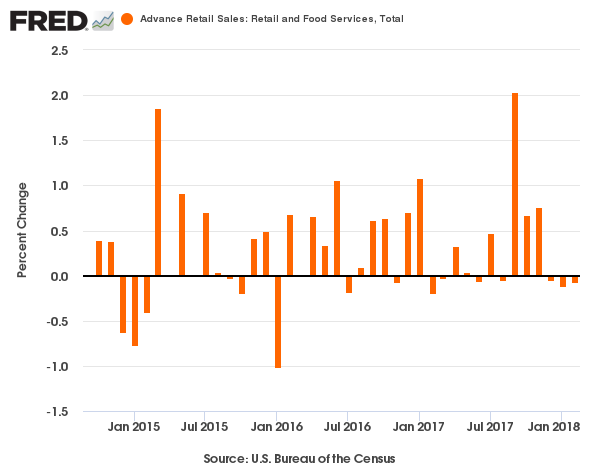Consumer spending has been soft in recent months, prompting some analysts to forecast trouble for the economy later this year. Perhaps, but looking through the monthly noise continues to paint an upbeat profile for retail sales. The growth rate has decelerated lately, but the year-over-year comparisons remain upbeat.
The stakes are high, of course. Consumer spending represents about three-quarters of economic activity in the US and focusing on the monthly reports looks worrisome. Sales slumped in February, marking the third straight monthly decline – the first trio of negative comparisons in three years, the US Census Bureau reported yesterday.
This could be the start of trouble for the business cycle, but it could just as easily turn out to be another temporary setback. One reason for thinking the weakness will pass includes the still-positive trend. The annual change in headline retail spending actually ticked higher last month, rising 4.0% vs. 3.9% for the year-over-year gain through January. The annual increases for retail spending excluding autos (and ex-food sales as well) also edged higher, suggesting that the core trend strengthened last month, albeit only slightly.
Pessimists are quick to note that the annual pace of retail growth is well off the recent high of 5.9% through last November. True, but expecting consumers to maintain that hot pace of spending was always a long shot. The worst you can say at this stage is that sales have decelerated to a moderate pace, but one that’s still healthy.
The fact that employment growth remains solid is no small reason for assuming that retail spending will continue to rise at a rate that keeps the broader economy humming. US companies added 287,000 jobs in February, the strongest monthly advance in almost two years. Meanwhile, the one-year trend in private payrolls firmed up to a 1.8% gain, the fastest rate in six months. Consumers have cut back on purchases lately, but the reason isn’t due to a stumbling labor market. That’s a powerful clue for thinking that retail sales will stabilize if not pick up in the months ahead.
“The consumer genuinely is taking a little bit of a breather,” JPMorgan Chase economist Michael Feroli noted yesterday. Although he’s at a loss to explain the recent weakness, the outlook remains upbeat, he told The Wall Street Journal. “We think the fundamentals are still supportive of better growth ahead.”
Tom Porcelli, chief US economist at RBC Capital Markets, agrees. “There’s clearly some buyers’ strike going on in the last couple of months, but we know that consumer fundamentals are incredibly sound,” he said via Bloomberg on Wednesday. “People may be surprised by the weaker numbers here but it’s par for the course after a stronger fourth quarter.”
Strengthening the case for expecting that the consumer’s appetite for spending will hold steady or ramp up is the positive trend for the business cycle overall. As reported in the March 11 edition of the US Business Cycle Risk Report, the probability is virtually zero that an NBER-defined recession has started. The profile is based on the Composite Recession Probability Index, which aggregates several business-cycle indexes to quantify US macro risk.
Nothing is absolute with business-cycle analytics, but the numbers overall still present a compelling case for interpreting the soft data on retail spending this year as another temporary soft patch rather than a warning. That could change, of course, depending on what the upcoming reports tell us. Based on what we know right now, however, it’s premature to argue that the latest downshift in the consumer sector is a smoking gun for thinking that the economy is slipping off the edge.



Pingback: Retail Sales Have Been Weak Lately, But The Trend Is Still Positive - TradingGods.net